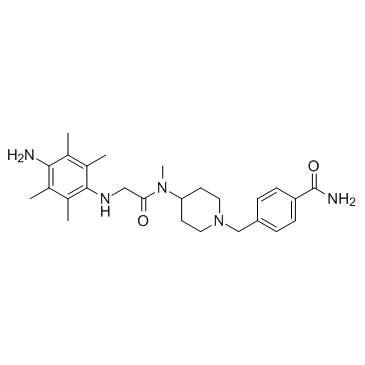| Description |
SUN11602 is a novel aniline compound with basic fibroblast growth factor-like activity.
|
| Related Catalog |
|
| In Vitro |
SUN11602 prevents glutamate-induced neuronal death in primary cultures of rat cerebrocortical neurons. SUN11602 increases the levels of CALB1 gene expression in cerebrocortical neurons[1]. SUN11602 exerts protective effects on hippocampal neurons through activation of FGFR1 and increases CalB expression[2]. SUN11602 promotes neurite outgrowth of primarily cultured rat hippocampal neurons[3].
|
| In Vivo |
In WT mice, SUN11602 increases the levels of newly synthesized Calb in cerebrocortical neurons and suppresses the glutamate-induced rise in intracellular Ca2+. This Ca2+-capturing ability of Calb allows the neurons to survive severe toxic conditions of glutamate[1]. Oral administration of SUN11602 at the midpoint of Aβ1-40 and ibotenate injections attenuate short-term memory impairment in the Y-maze test, as well as spatial learning deficits in the water maze task. In addition, the SUN11602 treatment inhibits the increase of peripheral-type benzodiazepine-binding sites (PTBBS),which are a marker for gliosis[3].
|
| Cell Assay |
Cerebrocortical neurons are pretreated with vehicle (Hanks’ Balanced Salt Solution), SUN11602, bFGF, or the other growth factors for 24 h prior to the onset of glutamate toxicity. Subsequently, 10 μL of the MTT solution (5 mg/mL) is added to each well (200 μL of culture medium) of the microplates. Neurons in each well are then dried for 24 h, and 200 μL of DMSO is poured into all of the wells in order to dissolve the reaction products thoroughly for the MTT assay[1].
|
| Animal Admin |
Rats: SUN11602 (0.1,1,and10mg/kg)is administered orally to the rat hippocampal-lesion model, once at 24 h after the Aβ1–40 injection. In the vehicle-treated groups, saline is administered instead of SUN11602[3].
|
| References |
[1]. Murayama N, et al. SUN11602, a novel aniline compound, mimics the neuroprotective mechanisms of basic fibroblast growth factor. ACS Chem Neurosci. 2013 Feb 20;4(2):266-76. [2]. Murayama N, et al. SUN11602-induced hyperexpression of calbindin D-28k is pivotal for the survival of hippocampal neurons under neurotoxic conditions. Brain Res. 2015 Jan 12;1594:71-81. [3]. Ogino R, et al. SUN11602 has basic fibroblast growth factor-like activity and attenuates neuronal damage and cognitive deficits in a rat model of Alzheimer's disease induced by amyloid β and excitatory amino acids. Brain Res. 2014 Oct 17;1585:159-66.
|
